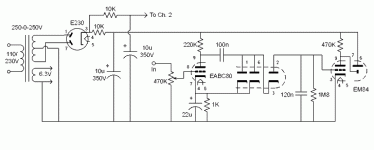An externally hosted image should be here but it was not working when we last tested it.
What mean "I LED"????
That is the current drawn through each lighted LED (No current through dimmed LEDs). It is an approximation because some are drawn by (divider and comparator) resistors.
it's to help you choose a "correct" value for R1 to avoid insufficient current to ur LEDs or overcurrent...it should qork quite well with the suggested part values...but if you're gonna use some ultrabright LEDs...you have to change the values according to the formula to achieve sufficient brightness...
i recently made a project using two lm3914's -- great chips, but i would suggest replacing r1 with a pot and adjusting the brightness that way -- then replacing with a correct resistor-- actually just follow the data sheet procedure, it works out pretty well
-chris
-chris
I think a "magic eye" type of tube with it's associated circuitry to drive it to show VU looks damn cool...anyone tried it?? I have seen a pair of em at my local speaker repair shop...tt guy built it on his own...maybe some of the tube guys will know what I'm talking about...here's a circuit...
Attachments
li_gangyi said:I think a "magic eye" type of tube with it's associated circuitry to drive it to show VU looks damn cool...anyone tried it?? I have seen a pair of em at my local speaker repair shop...tt guy built it on his own...maybe some of the tube guys will know what I'm talking about...here's a circuit...
i've seen some "magic eye" tube in a shop here, maybe u'd like to try
Just a quick note, if you are planning to make a sound level meter, you should use the LM3915, not the LM3914. The 3914 operates on a linear scale, which is quite useless for audio. The 3915's logarithmic scale is what you need. Also consider building a peak or average detector to give a more pleasant looking display (see the datasheet).
- Status
- Not open for further replies.
- Home
- Amplifiers
- Chip Amps
- What does mean?
